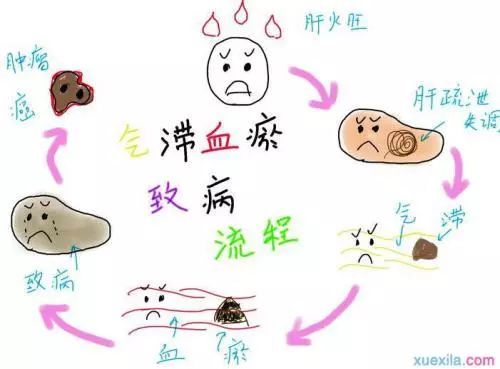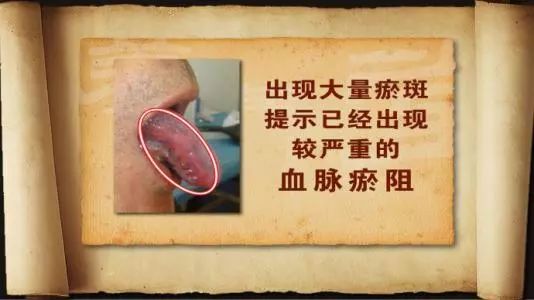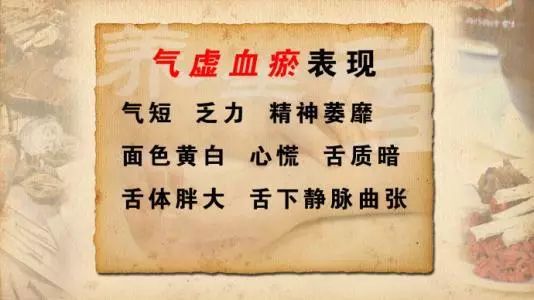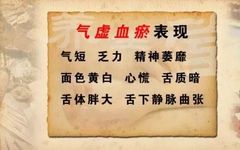
Blood stasis syndrome (血瘀证), refers to a set of symptoms caused by the obstruction of blood flow due to stasis. The causes of blood stasis syndrome include: cold pathogens causing stagnation, leading to blood obstruction; or stagnation of Qi (气滞) resulting in blood stasis; or due to Qi deficiency (气虚) leading to insufficient propulsion of blood; or due to trauma and other reasons causing blood to leak outside the vessels, which cannot be timely expelled and dissipated.
【Clinical Manifestations】
Pain that feels like stabbing or cutting, with a fixed location, tenderness upon palpation, often worsening at night.
Masses on the body surface appear bluish-purple; those in the abdomen are hard and immovable upon palpation, referred to as “symptomatic accumulation” (症积).
Recurrent bleeding that does not stop. The blood appears dark purple, mixed with clots, or the stool is black like tar.
Facial complexion is dark, skin is rough, lips and nails are dark purple, or there are subcutaneous purpura, or thread-like patterns on the skin, or visible veins on the abdomen, or swelling and pain in the lower limbs.
Women often experience amenorrhea. The tongue is dark purple, or shows stasis spots, and the pulse is thin and choppy.

This syndrome is characterized by stabbing pain, fixed location of pain, tenderness upon palpation, masses, dark purple lips, tongue, and nails, and a choppy pulse.
Due to blood stasis obstructing the meridians, pain occurs when there is obstruction, thus pain is the most prominent symptom of blood stasis syndrome.
Blood stasis is a tangible evil that hinders the movement of Qi, hence the pain is severe and fixed.

Due to slower blood circulation at night, the stasis worsens, hence the pain is more severe at night. If the stasis does not disperse and coagulates, it can form masses, hence externally visible masses appear bluish-purple and internal masses are hard and do not dissipate.
Bleeding occurs due to blood stasis obstructing the collaterals, hindering the movement of Qi and blood, causing blood to surge and break through the collaterals, leaking outside the meridians. Since the blood that leaks cannot be contained, it appears dark purple, or has coagulated into clots. Blood stasis internally obstructs, leading to poor movement of Qi and blood, resulting in a lack of nourishment to the skin, thus presenting with a dark complexion, rough skin, and dark purple lips, tongue, and nails.
Blood stasis internally obstructs, and if the Chong and Ren meridians are not open, it leads to amenorrhea, with thread-like red patterns, visible veins, and a thin and choppy pulse, all indicating obstruction of the meridians and hindered blood flow. A dark purple tongue and a thin and choppy pulse indicate blood stasis syndrome.

In women, many diseases are related to Qi and blood deficiency.
When Qi and blood are not harmonious, Qi stagnation and blood stasis lead to various issues:
Irregular menstruation, scanty menstrual flow, dysmenorrhea, amenorrhea, dark yellow or grayish complexion, pigmentation, wrinkles, skin laxity, obesity, breast hyperplasia, cysts, irritability, tidal fever and night sweats, cold hands and feet, insomnia with vivid dreams, constipation, menopausal syndrome, gynecological diseases…
Only with balanced and abundant Qi and blood can women maintain physical and mental health, and be as graceful as water! Traditional Chinese Medicine focuses on internal organ regulation, nourishing women’s Qi and blood, enhancing beauty, moistening the womb, and regulating menstruation, thereby improving women’s issues from the inside out…


Take off



